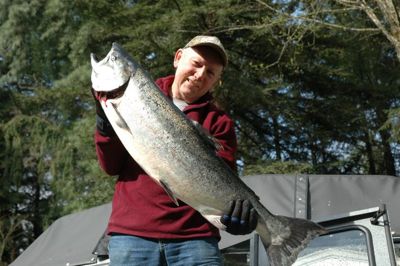forum
library
tutorial
contact

Fishery Managers Predict Strong
Spring, Summer, Fall Chinook Returns for 2012
by Staff
Chinook Observer, December 20, 2011
|
the film forum library tutorial contact |

|
Fishery Managers Predict Strong
by Staff
|
 Columbia River fishery managers are predicting strong returns in 2012, including a forecast return to the mouth of the river of 314,200 adult spring Chinook salmon. Such a return would be the fourth largest return on a record dating back to 1938.
Columbia River fishery managers are predicting strong returns in 2012, including a forecast return to the mouth of the river of 314,200 adult spring Chinook salmon. Such a return would be the fourth largest return on a record dating back to 1938.
The upriver spring Chinook return this year was 221,200. It followed a 2010 return that totaled 315,345 adults, the third strongest on record. The 2001 run marked a high of 440,300 adult upriver spring Chinook and it was followed by the second largest estimated return -- 335,214 in 2002.
The upriver spring Chinook run is comprised of stocks from several NOAA Fisheries-designated "environmentally significant units" and three geographically separate production areas above Bonneville Dam, which is located at river mile 146. Those areas are: 1) the Columbia River system upstream of the Yakima River (upper Columbia), 2) the Snake River system, and 3) Columbia River tributaries between Bonneville Dam and the Yakima River, excluding the Snake River (mid-Columbia).
Snake River summer Chinook are destined for areas upstream of Lower Granite Dam. Snake River wild spring/summer Chinook and upper Columbia wild spring Chinook are federally-listed under the Endangered Species Act.
The new Snake River spring/summer Chinook forecast pegs the return at 168,000 adult fish, again as counted at the mouth of the Columbia. The Snake River joins the Columbia in southeast Washington.
The forecast for the Snake River spring/summer return is 168,000, which would be the fourth largest return dating back to at least 1980. The top returns were more than 261,000 in 2001, 171,000 in 2002 and just under 170,000 in 2010.
The "wild," naturally produced portion of that Snake River spring/summer Chinook run is forecast to number 39,000, which would be the third highest on a record dating back to at least 1980.
The strong forecast is based in large part on the fact that the second largest number of spring Chinook jacks, on a record dating back to 1960, was counted this year at Bonneville Dam. The 50,946 jack total was second only to the 66,631 counted in 2009.
Jacks are young fish that return, generally, after only one year in the Pacific Ocean. The jack returns portend the strength of future year‚s returns since most returning spawners spend two or more years in saltwater.
An early season "outlook" produced by the Washington Department of Fish and Wildlife for 2012 says the fall Chinook return is likely to be similar to the actual 2011 return of about 600,000 adults.
The TAC forecast also includes a record return of Upper Columbia summer Chinook (91,200 fish) and continued strong returns of summer steelhead and fall Chinook. The only cloud in the 2012 forecast is coho salmon, where low jack counts this year suggest a weak return in 2012.
ODFW fishery managers this week predicted that the 2012 return of Willamette River spring Chinook spawners to the Columbia would number 83,400 fish. The Willamette feeds into the Columbia River at Portland.
That forecast is slightly higher than this year‚s return of 80,254 fish and should be high enough for a seven-day-a-week fishery and a two-fish bag limit when the fishing season in opens in January.
The 2012 fishing season for spring Chinook on the Columbia will be set in January, according to Steve Williams, ODFW assistant administrator for Columbia River Fisheries.
"I anticipate some fishing days in April and hope we'll be able to create the same kind of late season opportunity we enjoyed last year," he said. "Once we‚ve crunched the numbers and consulted with our Commission and our partners in Washington, we'll have a better handle on the details."
The final season will be set at a Jan. 26 meeting of the Columbia River Compact in Oregon City.
The Willamette River spring Chinook run passes through the lower Columbia River from February through May, with peak abundance during mid-March to mid-April, according to joint state staff reports from the Oregon and Washington departments of fish and wildlife. Migration through the lower Willamette River varies with water conditions but typically occurs from mid-March through April. Passage through the Willamette Falls fishway occurs from mid-April to mid-June, with peak passage typically in mid-May.
NOAA Fisheries Service in May 1999 classified spring Chinook destined for the Willamette River upstream of Willamette Falls in the Portland metropolitan area and the Clackamas River into a single "environmentally significant unit" and listed the wild component as a threatened species under the Endangered Species Act.
Accurate Willamette River spring Chinook run size estimates prior to 1946 are not available. But prior to 1990, the 1953 run was generally believed to be the largest on record, at 125,000 fish, and that run was predominantly wild.
The 1953 run was eclipsed by a return of 130,600 spring Chinook in 1990, comprised mainly of hatchery fish, according to the staff reports. A new record run was established in 2004 with a return of 144,400 fish, again comprised primarily of hatchery fish.
learn more on topics covered in the film
see the video
read the script
learn the songs
discussion forum
